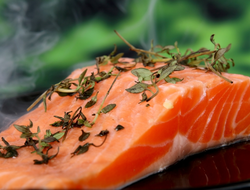Iodine or Iodide: what does it do for you?
Published: October 05, 2018
Iodine (I) is a halogen and non-metal element, but from a nutritional perspective is classified as a trace mineral required by and found in your body in small amounts.
Iodine freely occurs as I2.
Although your requirement for iodine is small the functional ionic form of iodide (I-) is a necessary component of important hormones which are involved in essential metabolic functions.
Dietary Sources of iodine
Sea water is the world’s major source of iodine and as such seafood such as lobster, clam, oysters and other sea water fish are good sources of iodine.
If you live in a coastal area sea mist is also a dependable source of iodine. Fresh water fish supply small amounts of iodine.
Click on the sources of iodine table to learn more about iodine/iodide content of foods.
Amounts provided are approximate as the iodine/iodide content of foods that you purchase will depend on where the food is grown.
Farming land in coastal areas is more likely to have a higher iodine content than inland farming areas.
The iodine content of the soil on which plants and animals are farmed is reflected in the iodine content of these plants and animals.
For instance, plants and animals farmed in coastal regions will likely have higher iodine content than plants and animals farmed inland. The amount and type of fertilizer used also influences the amount of iodine in foods such as grains, vegetables, and fruits.
The concentration of iodine in plants that animals consume will influence the animals’ iodine content. Land reclaimed from oceans is likely to be richer in iodine than land which is prone to flooding and where flood water leaches iodine from the soil.
The iodine content of drinking water is influenced not only by the soil content of the region, but also by the rock content of iodine.
Iodized salt is also another source of iodine.
Idiodinization of salt is mandatory in several countries, but not the US although many table salt products are ionized.
A ½ teaspoon of salt provides the RDA for iodine. However, excessive sodium consumption (a component of salt) is associated with increased risk for hypertension and other adverse health effects.
Food additives such as iodates (IO3-) added to bread dough products to improve texture of the products are another source of iodide and contribute up to 500 mg/100g of bread.
Recommendations for dietary intake
The recommended dietary allowance (RDA) for iodide, the average daily amount of iodide required which is considered sufficient to meet the needs of most healthy people, takes into account goitrogens (see below)...Link to the full article to learn more.
References
1.
Gropper, S.S., Smith, J.L. & Groff, J.L. (2005). Advanced Nutrition and Human Metabolism (4thEd.). Belmont, CA: Thomson Wadsworth.
2.
Whitney, E. & Rady Rolfes, S. (2005). Understanding Nutrition. Belmont, CA: Thomson Wadsworth

